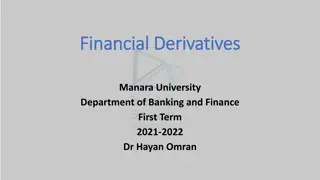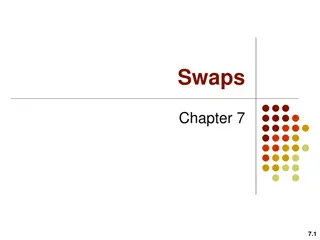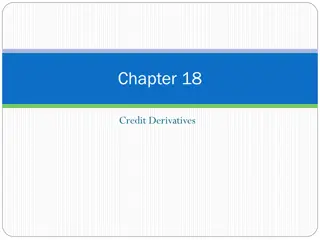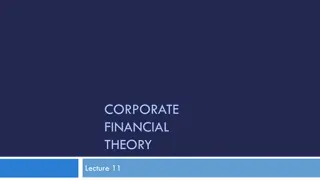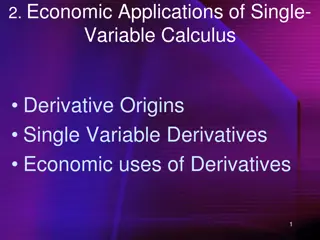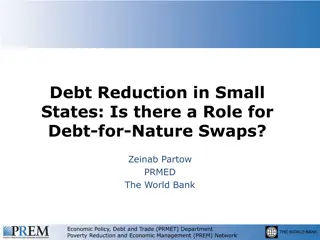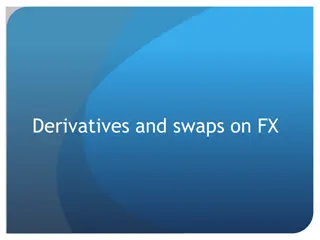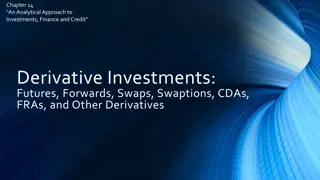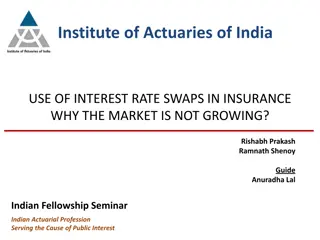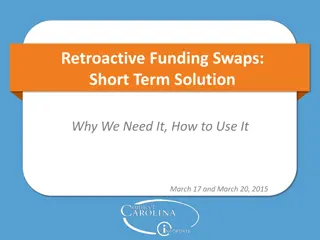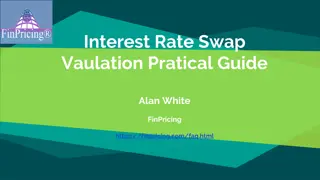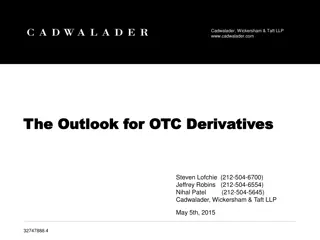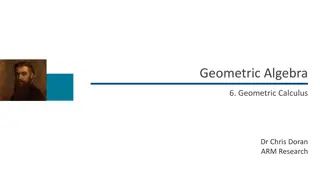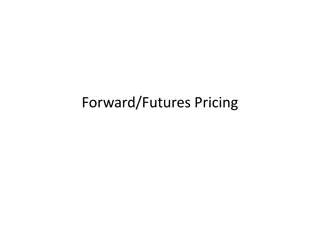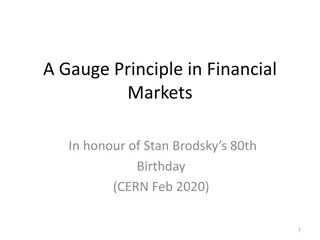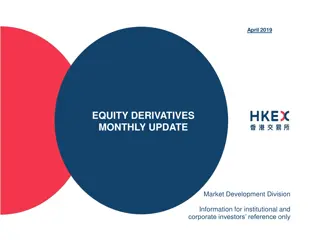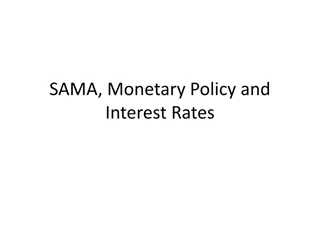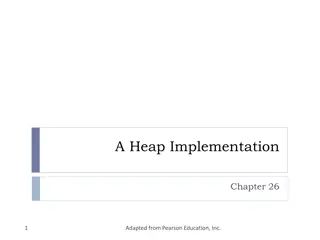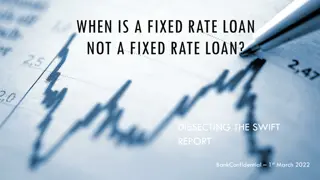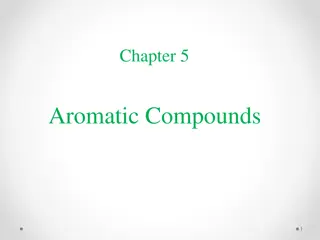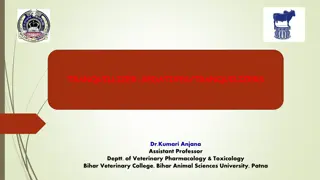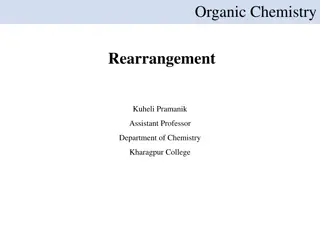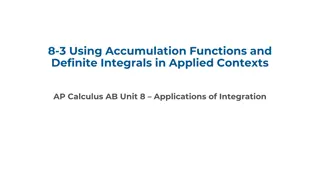Understanding Derivatives and Swaps: A Comprehensive Overview
Explore the concepts of derivatives and swaps, including their types, features, and the swap market. Delve into the details of how derivatives are used as contracts based on underlying financial assets, while swaps involve the exchange of financial instruments between parties. Learn about different types of swaps like interest rate swaps, currency swaps, and more.
Download Presentation

Please find below an Image/Link to download the presentation.
The content on the website is provided AS IS for your information and personal use only. It may not be sold, licensed, or shared on other websites without obtaining consent from the author. Download presentation by click this link. If you encounter any issues during the download, it is possible that the publisher has removed the file from their server.
E N D
Presentation Transcript
GOOD MORNING
Presentation on Swap Presented by : Sujita Thapa
Concept of Derivatives Aderivative is a contract between two or more parties whose value is based on an agreed- upon underlying financial asset, or security. Common underlying instruments include: bonds, commodities, currencies, interest rates, market indexes, and stocks.
Concept of Swap A swap is a derivative contract through which two parties exchange financial instruments. These instruments can be almost anything, but most swaps involve cash flows based on a national principal amount that both parties agree to. The parties that agree to swap is called counterparties. Swap is useful to hedge against interest rate risk and currency risk.
Cont.. The swap agreement defines the dates when the cash flows are to be paid and the way they are accrued and calculated. The cash flows are calculated over a notional principal amount. Contrary to a future, a forward or an option, the notional amount is usually not exchanged between counterparties. Parties enter into Swap to change the nature of cash flow.
Features of Swap Non-standardized contracts that are traded over the counter (OTC), Allow to deal with much longer horizons than exchange-traded instruments, Subject to credit risk. Swaps are contracts that exchange assets, liabilities, currencies, securities, equity participations and commodities.
Swap Market Swap market is market in which transaction on swap is carried out. Most swaps are traded over-the-counter (OTC).
Types of Swaps Interest rate swap Currency swap Equity swap Commodity swap
Currency Swap Currency swap is a contract between two parties to exchange series of cash flows in different currencies. The principle amount are usually exchanged at the beginning and at the end of the life of swap. Therefore there are three sets of cash flows: the exchange of principle at initiation and settlement and exchange of interest payments.
Interest rate swaps Swap is the agreement between the two parties that exchange sequences of cash flows for a set period of time Why swaps? Convert financial exposure Comparative advantage Speculate on interest rates , currencies , etc.
There are different types of swaps: Interest rate swaps, currency swaps, credit default swaps, asset swaps, trigger swaps, commodity swaps, total return swaps Interest rate swap is a contractual agreement between two parties to exchange interest payments Each participant in the swap is referred to as a party, or together, as counterparties. Financial institutions use interest rate swaps to manage credit risk, hedge potential losses, and earn income through speculation.
Interest rate swaps usually involve the exchange of a fixed interest rate for a floating rate, or vice versa, to reduce or increase exposure to fluctuations in interest rates or to obtain a marginally lower interest rate Swaps can be customized in many different ways There are potential benefits and risks for both parties in an interest rate swap. If interest rates rise, the payer benefits, because their fixed rate is unchanged, and the receiver now owes them the difference between the fixed rate and the floating rate. If interest rates drop, the receiver wins, because their floating rate is now lower than the fixed rate, and they will be receiving the difference from the payer
How it works? The most common type of interest rate swap is one in which Party A agrees to make payments to Party B based on a fixed interest rate, and Party B agrees to make payments to Party A based on a floating interest rate. The floating rate is tied to a reference rate (in almost all cases, the London Interbank Offered Rate, or LIBOR).
For example, assume that Charlie owns a $1,000,000 that pays him LIBOR + 1% every month. As LIBOR goes up and down, the payment Charlie receives changes. Now assume that Sandy owns a $1,000,000 investment that pays her 1.5% every month. The payment she receives never changes. Charlie decides that that he would rather lock in a constant payment and Sandy decides that she'd rather take a chance on receiving higher payments. So Charlie and Sandy agree to enter into an interest rate swap contract. Under the terms of their contract, Charlie agrees to pay Sandy LIBOR + 1% per month on a $1,000,000 principal amount (called the "notional principal" or "notional amount"). Sandy agrees to pay Charlie 1.5% per month on the $1,000,000 notional amount.
For instance: LIBOR = 0.25% Charlie receives a monthly payment of $12,500 from his investment ($1,000,000 x (0.25% + 1%)). Sandy receives a monthly payment of $15,000 from her investment ($1,000,000 x 1.5%). Now, under the terms of the swap agreement, Charlie owes Sandy $12,500 ($1,000,000 x LIBOR+1%) , and she owes him $15,000 ($1,000,000 x 1.5%). The two transactions partially offset each other and Sandy owes Charlie the difference: $2,500.
Types of interest rate swaps Plain vanilla swap (fixed to floating or vice-versa) Basis Swap (floating to floating) Interest rates swaps provides a way for business to hedge against their exposure to changes in interest rate swap


